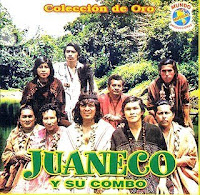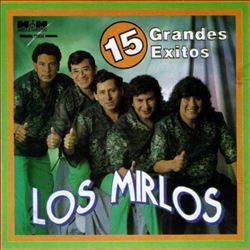I was staying with my teacher don Rómulo Magin in his hut in the jungle. He was playing an ancient transistor radio for me, barely bringing in the scratchy music of a distant station. The music was infectiously lively, and I asked him what it was. La música de la selva, he told me, grinning. Jungle music.
Cumbia is a popular music of Colombia, especially along the northern Caribbean coast. A form of cumbia is also found in Perú, called chicha, named after the popular fermented drink, usually made of maize. Peruvian chicha took Colombian cumbia rhythms and instrumentation and added the Andean elements of popular huayño music; and in turn chicha spun off two variants — tecnocumbia, which added synthesizers and other electronica to the mix, and cumbia amazónica. Jungle music.
 |
Cumbia amazónica developed in the 1960s in the larger Upper Amazonian towns such as Iquitos, Moyobamba, and Pucallpa, where the accordions of chicha were replaced by cheap, loud, portable garage-band instruments such as Farfisa organs and big-reverb guitars, and local bands played cumbias amazónicas for oil workers as a display of regional pride — what one commentator has called “eastern Peruvian wild west Amazon mining town jump up music.” They sang about partying, oil prospecting, and jungle life, often with wry tongue-in-cheek humor: My grandfather has died, ayayay, drinking liquor, ayayay, my grandfather has died, ayayay, drinking masato, ayayay. Their sense of their music’s regional and ethnic roots was encapsulated in the phrase poder verde, green power.
 |
Two long-surviving groups, Juaneco y Su Combo and Los Mirlos, are primarily associated with this music. The original Juaneco y su Combo was formed in 1966 in Pucallpa; it consisted of singer Wilindoro Cacique; guitarist Noé Fachín, called El brujo because it was said his melodies came to him during ayahuasca visions; and saxophonist Juan Wong Paredes, leader and principal composer, the original Juaneco. When Paredes’s son Juan Wong Popolizio took over the band, he traded in his accordion for a Farfisa organ.
The group put on their first public concert in Iquitos in 1967. The concert has spawned legends — that the crowd was so large that the army had to be called out; that the venue was too small for the crowd and the band played out in the street; that Fachín’s guitar was so erotically charged that rioting broke out, people ripping their clothes off. Half of the group, including Fachín, died in 1976 in a plane crash; Wong died in 2004. The group continues under the leadership of Mao Wong Lopez, the founder’s grandson. The only survivor of the original trio, Wilindoro Cacique, lives in a taxi garage in Pucallpa, and does occasional gigs under the name Wilindoro y la Leyenda Viva de Juaneco, Wilindoro and the living legend of Juaneco. The original name, with a new lineup, lives on.
Most distinctive about Juaneco y su Combo was their adoption of the symbols of indigenous Amazonia. While band members were mostly poor mestizos, their pride in local tradition led them to wear Shipibo cushmas and feather coronas onstage. “They think of it as their culture, even though they are not Shipibo,” says Olivier Conan, a New York musician who has been key to their revival. “It is a very important part of their whole music.”
Their song lyrics also embraced distinctively Amazonian themes and legends — Vacilando con ayahuasca, Floating with ayahuasca; El hijo de la runamula, Son of the spirit mule; El llanto de ayaymama, The weeping of the ayaymama bird; Mujer hilandera, Woman spinning. Here is a video of Vacilando con ayahuasca, which will give you an idea of the musical and performance conventions of the genre. The orgasmic female moaning for ayahuasca has always been part of the song, and no doubt contributed to its breakthrough popularity.
Los Mirlos was founded in 1973 by Jorge Rodriguez Grandez, who enlisted two of his brothers and a cousin to form the group. Many of their songs — Sonido amazónico, Amazonian sound; El milagro verde, The green miracle; Muchachita del oriente, Jungle girl; Fiesta en la selva, Party in the jungle — refer to the area of Moyobambo, in the departamento of San Martín, where Rodriguez was born, although he moved to Lima when he was very young. Guitarist Danny Johnson gave the band a darker sound — music critic Francisco Melgar Wong calls it “sinuous and reptilian” — which differentiated the group from its more cheerful contemporaries. Rodriguez has been outspoken about his regional roots. “I have spoken to my jungle,” he has said, “to all immigrants from Peru.” The following video of Muchachita del oriente gives a good idea of the kind of good-time party music Los Mirlos is still capable of putting out:
Both these groups have had a remarkable revival beginning in the 1990s, as their countercultural style appealed to a new generation of young people in Lima. Despite its recent embrace by the middle class, chicha remains an outsider music — an expression of migrants, nostalgia for home, hope for a better life. It is, above all, party music, a concept operationalized by the ubiquitous scantily-clad callipygian bailarinas who dance onstage while the band plays. The term chicha, very much like the term hip-hop in the United States, has come to refer to a broad range of limeño underclass culture — inexpensive folk housing, tabloid newspapers, outdoor concerts and dance parties in venues, such as empty parking lots, called chichodromos.
Cumbia amazónica brought an indigenous world to the attention of those who had previously been only dimly aware of it. Juaneco y su Combo and Los Mirlos achieved their primary success in the mid-70s, the time of the Amazon oil boom. Prior to that period, the axis of Peruvian indigenous discourse had run between Lima and Cuzco, and thus between Spanish and Inca culture. Indeed, the term indigenismo traditionally had little to do with indigenous peoples of the jungle; it was, instead, an identification that the upper-class light-brown trigueño elite in Cuzco made of themselves in connection with their own purported Inca heritage. Jungle Indians were chunchos, not worth thinking about.
Although there undoubtedly have been culturally exploitative currents in cumbia amazónica — take a look, for example, here — it was, in fact, revelatory. There had long been a profound social divide between urbanized mestizos and indigenous peoples of the jungle. But, according to music critic Ricardo León Almenara, when Juaneco y su Combo began to appear in Shipibo cushmas, it seemed for the first time that there might be something in common between the two worlds, if only a species of good-time jump-up bar music; and for the first time, says anthropologist César Ramos, mestizos and Shipibos would drink beer from the same glass at a festival.
An outstanding recent collection of classic cumbias, including songs by Juaneco y su Combo and Los Mirlos, entitled The Roots of Chicha: Psychedelic Cumbias from Peru, compiled by Olivier Conan on his Barbès Records label, can be found here.

- Previous Post: Best New Product of 2009
- Next Post: The Importance of Plant Knowledge
- More Articles Related to: Books and Art, The Amazon



I am trying to finish my earlier comment, in the meantime:
I am big fan of Sonidero style!
The same countercultural process has taken place in various parts of Latin America and slowly contributing to the healthy perception of the indigenous roots of the continent. I can think of the movements started by groups like Botellita de Jerez in Mexico,El Polen in Peru and Imperio Diablo in Argentina. These groups arranged concepts and titles of music, and people into a form that was fun and accepted by the lower classes. That is how punk turned into Tezcatlipunk, To be Aymara mean to be made of steel, and to be indigenous meant strength. These rhythms are part of the life or the barrios bravos, the ghettos and favelas,etc. In Argentina Cumbia Villera has been mixing with reggae and rap lately. In Mexico Jaguares, an all time favorite rock group has constantly sang about respect to the earth and brought Maya healers to send prayers in the middle of their concerts, in the US B-Side players sing “Mexica Reggae with a working visa”. The music and the groups not only connect people back to their traditions, they also help the working people (la gente del pueblo) to have hope, and party their hearts out.
Cuuuuummbiaaa!!!!
Okay, listen up everybody. There is going to be a cumbia party and barbecue over at Chuntaro’s house this Saturday!
Thank you. I learn new things every time you leave a comment.
Hi, great piece. Please don’t miss out on the band Chicha Libre–we are carrying on the tradition of this Cumbia Amazonica music, here in New York–with national/international tours coming up in summer 2009. Hope to see you there. Our CD is called Sonido Amazonico, and it is also on Barbès Records. Cheers, Greg B
Greg, I am delighted that you like the post and left a comment. I am a big fan of Chicha Libre; I have your CD, and I wrote about your band here. When will you be in Chicago? And are you planning to play in Lima? By the way, I have more on cumbia amazónica here and here. Please feel free to browse and let me know what you think.